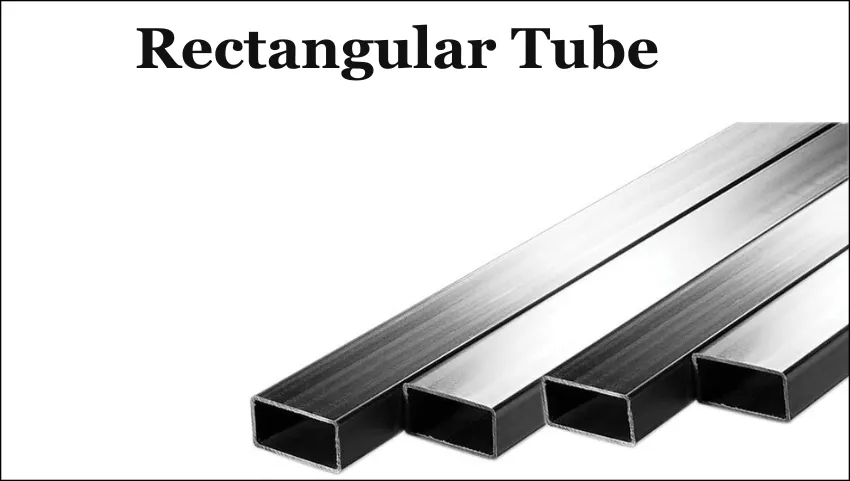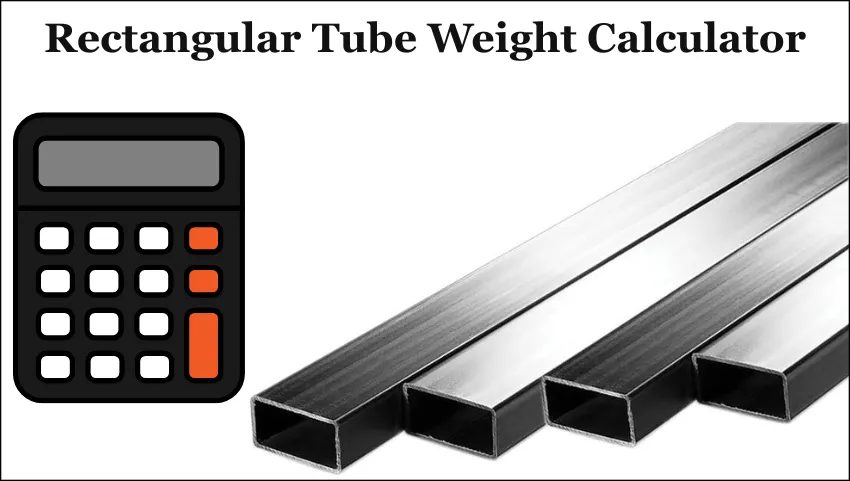Rectangular Tube Weight Calculator
Formula Used
Use our rectangular tube weight calculator to find precise tube weight for steel and other materials. Simple inputs for quick, reliable results.
Understanding the weight of rectangular tubes is crucial for engineers, builders, fabricators, and hobbyists. Whether dealing with construction structural elements, manufacturing frames, or DIY projects, knowing how to calculate the weight of rectangular tubes helps make informed decisions about materials, transportation, and costs. This article will explain the concept of rectangular tube weight, why it matters, and how to calculate it, and it will introduce useful tools like calculators to simplify the process.
What Is a Rectangular Tube?
A rectangular tube is a hollow steel or metal section with a rectangular cross-section. It is widely used as a structural element in:

- Construction frameworks
- Fabrication of machinery
- Furniture making
- Automotive and aerospace applications
The term “rectangular hollow section (RHS)” or “rectangular steel tube” is often used interchangeably. The shape has four sides with two pairs of parallel sides—height and width—and a uniform wall thickness all around.
Why Is Weight Calculation Important?
Calculating the weight of a rectangular tube is essential for several reasons:
- Material Cost Estimation: Most metals are charged by weight. Knowing accurate weight means budgeting materials realistically, reducing waste, and reducing cost.
- Structural Design: Weight impacts load calculations and structural integrity. Designers ensure safety and efficiency by knowing correct weights.
- Transportation and Handling: Knowing the weight helps in planning transportation logistics and avoids overloading.
- Inventory Management: Accurate weights assist in stock control and reordering materials.
Basic Terminology for Weight Calculation
Before diving into formulas, it is important to understand some terms:
- Height (H): The longer side of the rectangular tube cross-section, usually in millimeters or inches.
- Width (W): The shorter side of the rectangular tube cross-section.
- Thickness (T): The thickness of the tube wall.
- Length (L): The length of the tube section, often in meters or feet.
- Density (ρ): The mass per unit volume of the material used. For steel, it is approximately 7.85 g/cm³ or 7850 kg/m³.
The Formula to Calculate Weight of a Rectangular Tube
The weight of a rectangular tube is found by calculating the volume of the metal used in the tube and multiplying it by the density of the material.
Step 1: Calculate the Cross-Sectional Area of the Metal
Because the tube is hollow, subtract the inner area from the outer area to find the metal cross-sectional area : Area=(H×W)−[(H−2T)×(W−2T)]
Where,
- HHH = Outer height of the tube,
- WWW = Outer width of the tube,
- TTT = Wall thickness of the tube.
Step 2: Calculate the Volume
To find volume, multiply the cross-sectional area by the length of the tube :Volume=Area×L
Step 3: Calculate the Weight
Finally, multiply the volume by the density to obtain the weight : Weight=Volume×ρ
Weight Calculation Formula Summarized:
Weight=[(H×W)−(H−2T)×(W−2T)] ×L×ρ
Example to Understand Weight Calculation
Suppose we have a rectangular steel tube with:
- Height H=100 mm
- Width W=50 mm
- Wall thickness T=5 mm
- Length L=2 mL = 2
- Density of steel ρ=7850 kg/m³
Step 1: Calculate the cross-sectional (100×50)−(100−2×5)×(50−2×5)=5000−90×40=5000−3600=1400mm2
Convert to square meters: 1400mm2=1400×10−6=0.0014m2
Step 2: Calculate the 0.0014×2=0.0028m3
Step 3: Calculate the weight 0.0028×7850=21.98kg
So, the tube weighs approximately 22 kg.
Using a Rectangular Tube Weight Calculator
Doing these calculations by hand can be error-prone and time-consuming, especially for different sizes and wall thicknesses. That is why online rectangular tube weight calculators are very handy. These calculators require you to input:

- Height (H)
- Width (W)
- Thickness (T)
- Length (L)
- Material type or density (usually selectable steel, aluminum, etc.)
The calculator instantly provides the weight based on the above formula.
Advantages of Using Online Calculators
- Instant and accurate results
- Easy to use with adjustable parameters
- Helpful for quick project estimations
- Reduces errors from manual calculations
Important Tips When Calculating Rectangular Tube Weight
- Wall Thickness: Ensure the wall thickness is less than half the shorter side (width) of the tube.
- Material Density: Weight depends on the material. Steel density is about 7.85 g/cm³, but for aluminum, it is less (~2.7 g/cm³).
- Units: Be consistent with units (e.g., mm and m or inches and feet). Convert before calculating.
- Length: Be precise with length to get an accurate total weight.
- Tolerance: Manufacturing tolerances can cause slight variations in weight.
Common Uses of Rectangular Tubes by Weight
- Construction: Columns, beams, and supports; weight helps in structural safety checks.
- Fabrication: Frames for machinery, gates, and furniture—weight affects handling and transport.
- Automotive: Chassis and roll cages require exact weight to maintain performance.
- DIY Projects: Facilitates design decisions and purchase quantities.
How to Calculate Rectangular Tube Weight
- Measure the outer height, width, and wall thickness.
- Calculate the metal cross-sectional area by subtracting the hollow part.
- Multiply by the length to get the volume.
- Multiply by material density to get weight.
- Use online calculators for quick and accurate results.
Frequently Asked Questions
What is a rectangular tube weight calculator?
A rectangular tube weight calculator is an online tool that helps estimate the weight of hollow rectangular tubes by entering dimensions and material type.
Which dimensions are needed for calculating rectangular tube weight?
The required inputs are the tube’s height, width, wall thickness, and length, with the material density or type specified.
Why is wall thickness important in weight calculations?
Wall thickness determines how much metal is present in the tube; a thicker wall increases weight, while a thinner wall reduces it.
How do I choose density for my tube material?
Select the material type from the calculator (such as steel, aluminum, etc.), and the calculator will use standard density values for accurate results.
What unit should I use for measurements?
Use consistent units for all values (millimeters/meters or inches/feet) and convert if necessary to avoid calculation errors.
Final Thought
Understanding the weight of rectangular tubes is simple with the correct knowledge of basic dimensions, formulas, and material properties. This not only saves money and effort but also ensures safety and efficiency in designing and constructing with metal tubes. Using an online calculator can dramatically simplify this process and help professionals and hobbyists alike.
